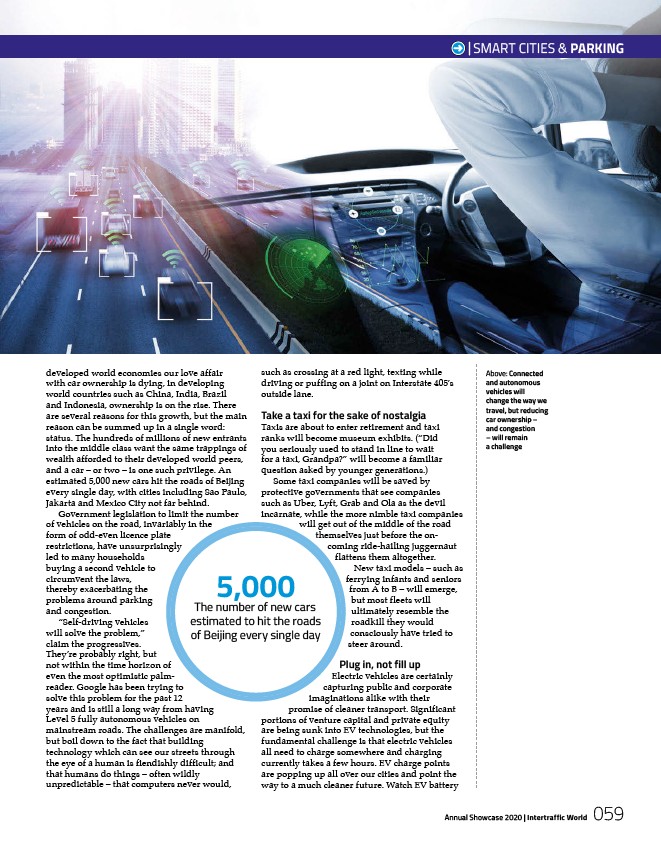
developed world economies our love affair
with car ownership is dying, in developing
world countries such as China, India, Brazil
and Indonesia, ownership is on the rise. There
are several reasons for this growth, but the main
reason can be summed up in a single word:
status. The hundreds of millions of new entrants
into the middle class want the same trappings of
wealth afforded to their developed world peers,
and a car – or two – is one such privilege. An
estimated 5,000 new cars hit the roads of Beijing
every single day, with cities including Sao Paulo,
Jakarta and Mexico City not far behind.
Government legislation to limit the number
of vehicles on the road, invariably in the
form of odd-even licence plate
restrictions, have unsurprisingly
led to many households
buying a second vehicle to
circumvent the laws,
thereby exacerbating the
problems around parking
and congestion.
“Self-driving vehicles
will solve the problem,”
claim the progressives.
They’re probably right, but
not within the time horizon of
even the most optimistic palmreader.
Google has been trying to
5,000 The number of new cars
estimated to hit the roads
of Beijing every single day
solve this problem for the past 12
years and is still a long way from having
Level 5 fully autonomous vehicles on
mainstream roads. The challenges are manifold,
but boil down to the fact that building
technology which can see our streets through
the eye of a human is fiendishly difficult; and
that humans do things – often wildly
unpredictable – that computers never would,
such as crossing at a red light, texting while
driving or puffing on a joint on Interstate 405’s
outside lane.
Take a taxi for the sake of nostalgia
Taxis are about to enter retirement and taxi
ranks will become museum exhibits. (“Did
you seriously used to stand in line to wait
for a taxi, Grandpa?” will become a familiar
question asked by younger generations.)
Some taxi companies will be saved by
protective governments that see companies
such as Uber, Lyft, Grab and Ola as the devil
incarnate, while the more nimble taxi companies
will get out of the middle of the road
themselves just before the oncoming
ride-hailing juggernaut
flattens them altogether.
New taxi models – such as
ferrying infants and seniors
from A to B – will emerge,
but most fleets will
ultimately resemble the
roadkill they would
consciously have tried to
steer around.
Plug in, not fill up
Electric vehicles are certainly
capturing public and corporate
imaginations alike with their
promise of cleaner transport. Significant
portions of venture capital and private equity
are being sunk into EV technologies, but the
fundamental challenge is that electric vehicles
all need to charge somewhere and charging
currently takes a few hours. EV charge points
are popping up all over our cities and point the
way to a much cleaner future. Watch EV battery
| SMART CITIES & PARKING
Above: Connected
and autonomous
vehicles will
change the way we
travel, but reducing
car ownership –
and congestion
– will remain
a challenge
Annual Showcase 2020 | Intertraffic World
059